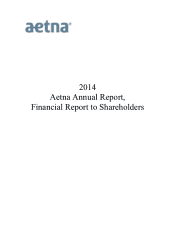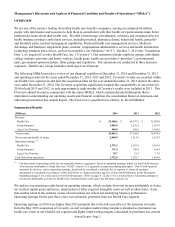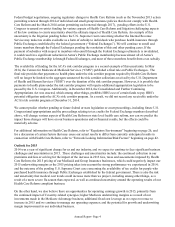Aetna 2014 Annual Report Download - page 10
Download and view the complete annual report
Please find page 10 of the 2014 Aetna annual report below. You can navigate through the pages in the report by either clicking on the pages listed below, or by using the keyword search tool below to find specific information within the annual report.Annual Report- Page 4
Federal budget negotiations, ongoing regulatory changes to Health Care Reform (such as the November 2013 action
permitting renewal through 2014 of individual and small group insurance policies that do not comply with Health
Care Reform and the March 2014 action permitting such renewal through 2017), pending efforts in the U.S.
Congress to amend or restrict funding for various aspects of Health Care Reform and litigation challenging aspects
of the law continue to create uncertainty about the ultimate impact of Health Care Reform. An example of this
uncertainty is the litigation pending before the U.S. Supreme Court concerning whether the Internal Revenue
Service may make tax credits available as a form of subsidy to individuals who purchase health insurance through
Public Exchanges established by the federal government (“Federal Exchanges”). We will continue to enroll and
insure members through the Federal Exchanges pending the resolution of this and other pending cases. If the
payment of subsidies with respect to members who enroll through the Federal Exchanges ultimately is invalidated,
it could result in a significant reduction in Aetna’s Public Exchange membership because almost all of Aetna’s
Public Exchange membership is through Federal Exchanges, and most of those members benefit from a tax subsidy.
The availability of funding for the ACA’s risk corridor program is a second example of this uncertainty. In May
2014, the Centers for Medicare & Medicaid Services (“CMS”) published a final rule on Public Exchanges. The
final rule provides that payments to health plans under the risk corridor program required by Health Care Reform
will no longer be limited to the aggregate amount of the risk corridor collections received by the U.S. Department
of Health and Human Services (“HHS”) over the duration of the risk corridor program. However, it is possible that
payments to health plans under the risk corridor program will require additional appropriation legislation to be
passed by the U.S. Congress. Additionally, in December 2014, the Consolidated and Further Continuing
Appropriations Act was enacted, which among other things, prohibits HHS’s use of certain funds to pay HHS’s
potential obligation under the ACA’s risk corridor program. As a result, we did not record any receivable under the
ACA’s risk corridor program at December 31, 2014.
We cannot predict whether pending or future federal or state legislation or court proceedings, including future U.S.
Congressional appropriations and the proceedings relating to tax credits for Federal Exchange members described
above, will change various aspects of Health Care Reform or state level health care reform, nor can we predict the
impact those changes will have on our business operations and/or financial results, but the effects could be
materially adverse.
For additional information on Health Care Reform, refer to “Regulatory Environment” beginning on page 26, and
for a discussion of certain factors that may cause our actual results to differ from currently anticipated results in
connection with Health Care Reform, refer to “Forward-Looking Information/Risk Factors” beginning on page 42.
Outlook for 2015
2014 was a year of significant change for us and our industry, and we expect to continue to face significant business
challenges and uncertainties in 2015. These challenges and uncertainties include: the continued collection in our
premiums and fees or solving for the impact of the increase in 2015 fees, taxes and assessments imposed by Health
Care Reform; the 2015 pricing of our Medicaid and Group Insurance businesses, which could negatively impact our
2015 underwriting margins as the 2015 pricing takes into account the strong performance we experienced in 2014;
and the outcome of the pending U.S. Supreme Court case concerning the availability of tax credits for people who
purchased health insurance through Public Exchanges established by the federal government. There is also the risk
and uncertainty that medical cost trends could increase more than we project, including among other things, as a
result of a more severe flu season than expected, as well as continued uncertainty around the operating results of our
Health Care Reform compliant business.
On the other hand, we also believe there are opportunities for operating earnings growth in 2015, primarily from
the continued impact of Coventry-related synergies; higher Medicare underwriting margins as a result of our
investments made in the Medicare Advantage business; additional fixed cost leverage as we expect revenue to
increase in 2015 and we continue to manage our operating expenses; and the potential for growth and underwriting
margin improvement in our individual business.























